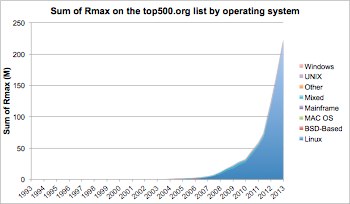Today the Linux Foundation released a short analysis paper on 20 years of data collected by the Top500.org supercomputer list. Released each June and November, the Top500 list has ranked the world’s fastest supercomputers since 1993.
The Linux community has delighted in watching Linux become the dominant OS running on Top500 machines over the past decade. And there has been no shortage of stories chronicling the rise of Linux in supercomputing. But we found the data tells another, less obvious story as well.
 RMax, the measure by which computing power is ranked on the Top500, has grown steadily over the past 20 years with advances in hardware and system architecture starting at gigaflop/second in 1993, and increasing by a factor of three to petflop/second in 2013. But when the sum of RMax for each year is broken out by operating system over this same time period, it shows a meteoric rise of Linux as a percent of total computing power, starting in the mid 2000’s.
RMax, the measure by which computing power is ranked on the Top500, has grown steadily over the past 20 years with advances in hardware and system architecture starting at gigaflop/second in 1993, and increasing by a factor of three to petflop/second in 2013. But when the sum of RMax for each year is broken out by operating system over this same time period, it shows a meteoric rise of Linux as a percent of total computing power, starting in the mid 2000’s.
As the paper explains in more detail, Unix dominated the Top500 when high performance computing systems were essentially ever-growing piles of homogenous processors. But as systems evolved to the complex hybrid technologies we see today, Linux took over as the dominant operating system. Why?
Open Source Linux Drives Supercomputing Capacity
While the silicon itself is primarily responsible for the rise of RMax, it was the flexible, low-cost, open source Linux operating system that let researchers experiment with groundbreaking system designs, without breaking the bank.
In short, to quote from the paper directly: “Linux is not only responsible for supporting the majority of supercomputers today, but it also was the single driving force behind the disproportionate growth in supercomputing capacity over the past decade.”
We’re talking, here, about computers such as IBM’s Linux-based Roadrunner machine, which broke the Petaflop/s barrier in 2008 and was used to map the neural pathways for vision in the human brain. Or Cray’s Titan supercomputer, the first CPU/GPU hybrid with a 17 Petaflop/s performance, that’s now running climate change scenarios to help avert ecological disaster.
So come November, we’ll no doubt revel again in counting the number of Linux machines on the Top500. But we’ll also feel good knowing that Linux is driving the advancement of supercomputing, and by extension, scientific research and discovery.
Download the full paper, “20 Years of Top500.org Supercomputer Data Links Linux With Advances in Computing Performance,” from LinuxFoundation.org.

